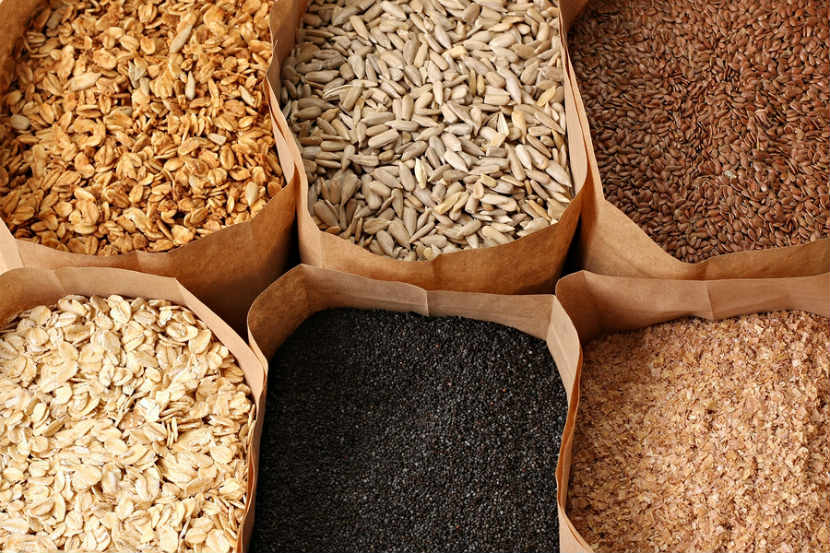
Health Canada recommends that meals contain whole grain foods. Whole grains are versatile and tasty but it may be challenging to figure out how to get more into your diet. Read on for tips on buying and preparing whole grains.
What are whole grains?
Whole grains are grains which have undergone the least amount of processing. This means that all three parts of the grain are preserved, including the bran, germ, and endosperm.
The bran is the protective covering of the grain and provides fibre, B vitamins, and minerals.
The germ nourishes the seed and is the source of new growth in the plant. It provides mostly vitamins, including B vitamins and vitamin E, minerals and healthy fats.
The endosperm is the inner seed and provides carbohydrate and protein. It also provides vitamins and minerals.
Why are whole grains good for you?
Since whole grains are made from the entire grain, they have more fibre, protein, vitamins, minerals and antioxidants compared to refined grains. Getting more fibre in your diet may help reduce your risk of diseases like type 2 diabetes, heart disease, stroke and cancer.
How do I know I am getting a whole grain product?
Choosing whole grains can be easier than you think if you check the ingredient list on food labels. To make sure whole grains are the main ingredient, they should appear first on the ingredient list. Look for ingredients like "whole grain whole wheat flour", “whole rye”, “whole oat” or “oatmeal”, "whole corn”, “whole barley” and other grains that start with “whole”.
Don't be fooled by multigrain products, which may include a variety of different grains but may not include whole grains.
What about whole wheat?
Whole wheat is usually a refined grain, though there are exceptions. Refined grains are grains that have had some or all of the germ and bran removed from the kernel. Examples of refined grains are white flour, white rice, white pasta, whole wheat flour, and cream of wheat cereal.
Whole wheat flour contains at least 95% of the wheat kernel, but most of the germ and some of the bran is missing. Therefore, products labelled as 100% whole wheat or 60% whole wheat are NOT whole grain products.
Have you tried some of these whole grains?
Wondering what to choose at the grocery store, or how to use some different grains? Try some of the following whole grains.
Amaranth*
- tiny, circular grain
- cream-colour
- store in a tightly sealed container, in the refrigerator
- mild, sweet, nutty flavour
- try boiling it as hot cereal, or ground into flour for breads, muffins, pancakes, and pastas, popped like popcorn, or toasted in a stir-fry
Bulgur
- produced from wheat
- ranges in colour from cream to brown, similar in appearance to sunflower seeds
- store in a tightly sealed container, in the refrigerator
- has a mild nutty flavour
- since it’s precooked, it is quick to prepare as a side-dish, pilaf or salad
- try this fresh and nutritious Chicken Bulgur Salad
Millet*
- tiny, circular granules
- colour ranges from white to gray to yellow to red
- store in a tightly sealed container, in the refrigerator
- slightly sweet, nut-like flavour
- is used as a side dish similar to couscous or rice, or for hot breakfast cereal
Quinoa*
Spelt
- oval in appearance
- yellow-brown
- store in a tightly sealed container, in the refrigerator
- deep nut-like flavour
- a distant cousin to wheat, it can be ground into flour to be used in breads, baked goods, and pasta, but it can also be prepared as an alternative to rice
Triticale
- a hybrid between wheat and rye, and looks similar to both grains
- comes as cracked, flaked or as flour
- store in a tightly sealed container, in the refrigerator
- a substitute for both rye and wheat in recipes and can be used in breads, muffins, pasta, waffles, and cereals
Other whole grains include barley, brown rice*, buckwheat*, corn*, kamut, oats, rye, sorghum, and wheat
*gluten free whole grains. Read this article about oats and the gluten free diet.
Preparation
|
Whole grain (1 cup)
|
Amount of water
|
Bring to a boil, then simmer for
|
Cooked amount
|
|
Amaranth
|
2 cups
|
20-25 minutes
|
3 1/2 cups
|
|
Bulgur
|
2 cups
|
10-12 minutes
|
3 cups
|
|
Millet, hulled
|
2 1/2 cups
|
25-35 minutes
|
4 cups
|
|
Quinoa
|
2 cups
|
12-15 minutes
|
3+ cups
|
|
Spelt
|
4 cups
|
soak overnight then cook 45-60 minutes
|
3 cups
|
|
Triticale, flaked
|
2 cups
|
12-15 minutes
|
2+ cups
|
Recipes to try:
Beet and Barley Salad
Overnight Apple Pie Oatmeal
Chicken Corn Chowder
Almond Coconut Granola
Turkey Koftas with Cumin Scented Brown Rice
Sweet Chili Tofu Stir-Fry
How can a dietitian help?
Dietitians can support you throughout many phases of your life from pregnancy to eating well when you are older. Counselling sessions with a dietitian can also help you to prevent and treat health conditions like diabetes and heart disease. Your dietitian can also give you tips on label reading, grocery shopping and meal prep to help increase the amount of whole grains in your diet. Connect with a dietitian today!
Bottom line
Choose whole grains more often for a nutritional boost! Reading food labels is the best way to spot whole grains.
You may also be interested in:
How to Choose Whole Grains
How to Choose the Best Sliced Bread
All About Whole Grains
Top 5 Reasons to See a Dietitian
This article was written and reviewed by dietitians from Dietitians of Canada. The advice in this article is intended as general information and should not replace advice given by your dietitian or healthcare provider.
Last Update – February 24, 2023